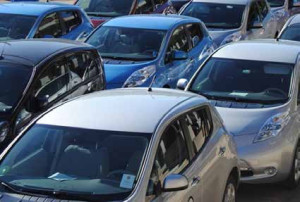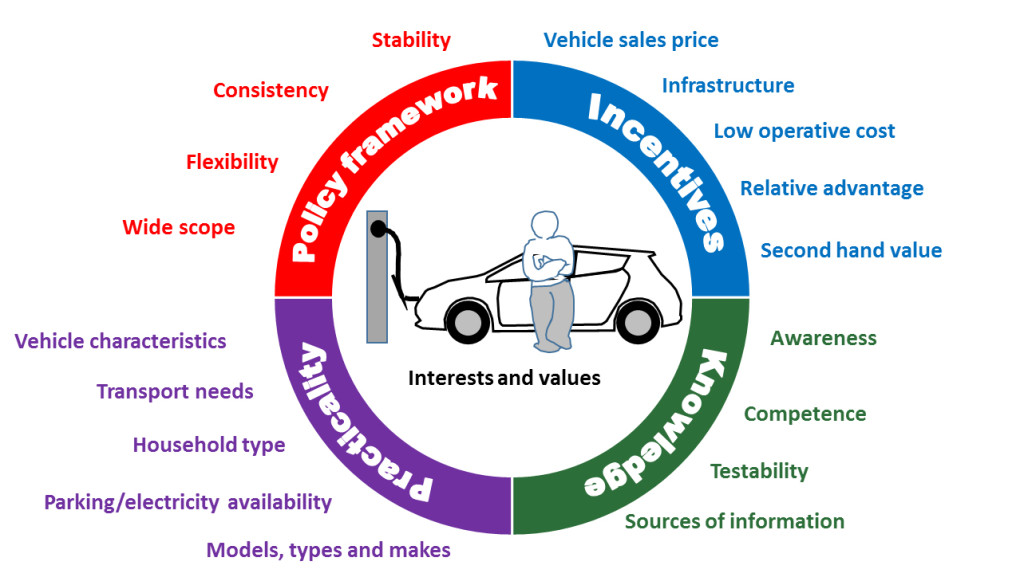Norway has become the number one country for Battery Electric Vehicles (BEV) in the world. In 2015 more than 2 per cent of the total car fleet are BEVs and BEVs and alone accounts for over 17% of new car sales. Generous economic incentives and a range of other factors have been important for the success.
The EU research project COMPETT has studied the Main factors influencing the BEV diffusion process. The results are now available in different reports.
Consumers will choose BEVs if they find it beneficial. The main factors to make consumers buy an electric vehicle are:
- Their attitudes and values, which make them more (environment, technology) or less (traditionalist) interested in BEVs. How these values limit or support a decision to buy a BEV, will be influenced by the other four factors.
- Consumers need to know about BEVs, i.e. be aware of the BEVs characteristics, through reliable information sources (incl. producers, authorities) and testing.
- The vehicles need to be practical, reliable, and economically viable and meet the users’ needs. Users must have parking with electricity available. The practicality depends on household type (single-/multi-vehicle), availability of types, makes and models, and country specific factors such as driving distances and climate.
- The policy framework should be stable over time to reduce risk for market actors, i.e. consistent in scope and communication, but also flexible to allow for unexpected developments and wide in scope to allow for business creativity.
- Incentives will improve the purchase process by reducing the price disadvantage, and provide users with relative advantages. Low tax on electricity, high tax on fossil fuels and the low energy consumption of BEVs are parts of the picture. Consumers may think primarily in a short-term perspective, and need to see that BEVs are favourable 3-5 years ahead. Local incentives can provide enough relative advantage to get diffusion started. Public charging stations make life with a BEV easier. This infrastructure may not materialize without incentives in the initial phases.
COMPETTs main learnings on taking BEVs into use to a greater degree are:
- Important barriers to BEV diffusion are range, price, awareness, and the availability of charging infrastructure. Society can support BEV diffusion by introducing flexible policies and incentives that reduce these barriers.
- BEVs can cover a large share of people’s transportation needs. The current selection of BEVs and their characteristics match people’s needs better than before. A larger selection of vehicles will stimulate future diffusion.
- Multi-vehicle households and fleets have the best ability to take BEVs into use.
- BEV owners mainly charge at home in private parking places. Some owners do so at work. Charging in other public locations is rare, and on average, the owners fast-charge 14 times per year. Public infrastructure can extend the range of BEVs and increase their usefulness.
- Government costs will be significant when economic incentives lead to a rapid take-up. Smart policy formulation can reduce the burden on public budgets. Purchase incentives can be offset by progressive taxes on polluting vehicles.
- Awareness raising and schemes to allow testing are important in the early phase of BEV diffusion but will not lead to significant sales unless coupled with incentives. Later in the diffusion process, there are new potential customer groups who have scarce knowledge of BEVs. A national communication strategy will therefore be a valuable tool in speeding up EV diffusion. An important part of such a communication plan will be to spread information about BEV assets such as a comfortable ride, the high energy efficiency leading to low energy costs and the advantages of being able to charge at home.
- User incentives providing BEV owners with a relative advantage, can be very effective in the absence of purchase incentives; an example is access to bus lanes, free parking and free toll roads (or congestion charges).
Electric Car Incentives in Norway
| Incentives | Introduced | Benefits for users today, changed relative advantage | Future of incentives | |
| Exemption from registration tax | 1990/1996 | The tax is based on emission and weight. Example of ICE vehicles taxes: VW Up 3000 €. VW Golf: 6000-9000 €. The tax makes the vehicles competing with BEVs more expensive | Continued until 2020. Will be reviewed against the achievement towards the Norwegian climate goals for 2020 and 2030. For ICE vehicles the registration tax will be tuned further towards reducing the emissions from these vehicles The government will also evaluate if PHEVs with a long EV-only drive mode should be more supported in the tax system, and if so how. | |
| VAT exemption | 2001 | Vehicles competing with BEVs are levied a VAT of 25% on sales price minus registration tax. | Unchanged through the end of 2017. Will consider replacing it with a subsidy scheme that will initially be at the level of the value of the VAT exemption. A maximum subsidy per car may be set, but without leading to large price increases for any BEV models. In the future this incentive may be ramped down | |
| Reduced annual vehicle license fee | 1996/2004 | Three rates apply for private cars. BEVs and hydrogen vehicles 52 € (2014-figures). ICE vehicle rates: 360-420 €. | Half rate of ICE vehicles could be introduced from 01.01.2018 and full rate from 2020, i.e. the incentive will be removed from that year. | |
| Reduced company car tax | 2000 | The company-car tax is lower for BEVs. Most BEVs are not company cars. | This incentive may be removed from 2018 | |
| Free toll roads | 1997 | Large impact when toll roads are expensive. In the Oslo-area the saved costs are 600-1 000 € per year for commuters. Some places tolls exceeds 2 500 €/year | The government will appraise the environmental effects of introducing differentiated fees for toll roads (main roads and toll rings around cities) and ferries based on the environmental characteristics of vehicles as well as a low rate for zero-emission vehicles. | |
| Reduced fares on ferries | 2009 | Similar to toll roads saving money for those using car ferries frequently. Can be important in some areas. | ||
| Financial support for charging stations | 2009 | Reduce the economic risk for investors establishing charging stations. These stations contribute to reduced range anxiety and an expanded BEV market. | ||
| Financial support for fast charge stations | 2011 | More fast-charging stations become available, increasing BEV miles driven and the total BEV market including fleets. | A new support program was launched by the national energy conservation support agency, Enova, in the fall of 2015 | |
| Access to bus lanes | 2003/2005 | BEV users save time driving to work in the bus lane during rush hours. Very efficient, high value to user in regions with large rush-hour congestion. Only a limited number of vehicles can use the bus lane. Can lead to increased vehicle ownership. | A process will be initiated to give local authorities the possibility of introducing restrictions in their jurisdictional district if zero emission vehicles hinder busses’ ability to navigate the bus lanes. | |
| Free parking | 1999 | The benefit for users is to get a parking space where these are scarce or expensive and to save time looking for a space. Impact depends on the number of spaces available. | Local authorities will be given the authority to decide whether this incentive is to continue in their jurisdictional district | |
| Free charging | Not regulated in national laws, but is often bundled with free parking | Local authorities will be given the authority to decide whether this incentive is to continue in their district | ||
COMPETT was a co-operation between the Institute of Transport Economics (TØI) in Norway, The Austrian Energy Agency (AEA), the University College Buskerud and Vestfold in Norway, Kongsberg Innovation in Norway and the Danish Road Directorate (DRD). The COMPETT project was jointly financed by the EU’s 7th Framework Programme, Transnova, the Norwegian Public Roads Administration, the Research Council of Norway (RCN), the Austrian Research Promotion Agency (FFG) and the Ministry of Science, Innovation and Higher Education in Denmark.
More information:
Reports are found on www.compett.org and www.toi.no.
The main report sums up the findings of COMPETT. Link to full report in English.
 Contact: Contact:Erik Figenbaum Erik.Figenbaum@toi.no TØI, Norway |








Follow us: